Stephen Enzweiler, Cathedral Historian
Part 2 in a series
The first Eucharistic Congress of the United States, held in 1895 on the campus of Catholic University in Washington, D.C., brought together clergy and bishops from across the nation in a first-of-its-kind assembly to do just one thing: proclaim the real presence of Jesus Christ in the Holy Eucharist.
“Our main object,” the official report stated, was to “call the attention of the priests of the East to the Eucharistic movement and to awaken the interest of the laity in it.” The congress — organized under the auspices of the Priests’ Eucharistic League of America, with the blessing of Pope Leo XIII and presided over by the Diocese of Covington’s Bishop Camillus Maes — was a resounding success. So much so, that at least five more national congresses would come to be held in the United States alone before Bishop Maes’ death in 1915.
But it started with this first one, memorialized for posterity in the stained-glass window we see today in the Blessed Sacrament Chapel of Covington’s Cathedral Basilica. The scene shows the Eucharistic procession at the conclusion of the Congress moving toward an altar erected beneath the portico arches of Catholic University’s newly dedicated McMahon Hall. Bishop Maes, vested in a golden cope, carries the ostensorium containing the Holy Eucharist amid a throng of bishops, priests and faithful. Though not historically accurate in some of its details, the scene is undoubtedly meant to evoke the joy and accomplishment of that First National Eucharistic Congress.
But the window is more than this. It seems to have been Bishop Maes’s intention not simply to illustrate the American Church’s accomplishment, nor even to emphasize the necessity for belief and veneration of the real presence, but also to challenge us to look deeper into the broader story of why Eucharistic Congresses were necessary in the first place. By the 1880’s, the slow decline of religion in general had become a concern to the Church in both Europe and in America. More worrisome was the steep decline among both clergy and lay faithful of belief in the “real presence” itself.
It may be said that the roots of this decline in religion can be traced back to the Enlightenment, an intellectual and philosophical movement that dominated Europe in the 17th and 18th centuries. Its central doctrines were opposed to the rule of monarchy and the power and influence of the Catholic Church in society. It focused on a range of ideas including individual liberty, natural rights, human happiness, the value of reason, scientific evidence, and ideals such as progress, constitutional government, and the separation of church and state.
Where monarchs and ruling nobility had once been viewed as an earthly representation of an eternal order modeled on the City of God, Enlightenment thought was seen as a mutually beneficial social contract among the citizenry with the aim of protecting their natural rights and self-interests at all costs. Religion came to be viewed as a threat to individualism, and religious beliefs and practices were cast aside in lieu of secular alternatives. What is clear from history, however, is that the Catholic Church became one of the main targets of Enlightenment intellectuals who systematically questioned every aspect of society and government.
The effects of Enlightenment thinking first manifested in 1776 with the outbreak of the American Revolution. The colonies rejected the rule of King George III in favor of self-government and the natural rights of man. Centuries of religious persecution in England had fostered the independent growth of religion in the American colonies. It was a powerful, cultural synthesis of Evangelical Protestantism, republicanism, and reason that provided a moral sanction for opposition to British rule, an assurance to every American that revolution was justified in the sight of God. Religion became a major contributor to winning the Revolutionary War and it helped in shaping the new Republic. Yet, the founding fathers retained the basic Enlightenment principles when crafting a new Constitution, declaring “We the People” while simultaneously separating Church and state and omitting any thought or dependence on Divine institution.
Enlightenment thinking took a decidedly more tragic turn in 1789 with the French Revolution that followed. With nearly all of France’s 28 million citizens as Roman Catholics, and with the Church second in power only to the monarchy itself, the new revolutionary government’s first action was to declare the Catholic Church an enemy of the state. It cancelled the taxing power of the Church and confiscated all its property. Clergy were hunted down and persecuted with ferocious and dogged tenacity. Unknown thousands of priests, bishops and nuns were massacred. Churches and sanctuaries were destroyed, convents and monasteries pillaged and sacked, the Holy Eucharist desecrated.
In September 1792, three Church bishops and hundreds of priests were brutally murdered by angry mobs in what became known as the September Massacres. An entire convent of Carmelite nuns were guillotined in Compiegne for refusing to deny their faith. The Archbishop of Paris was forced to resign his duties and march through the streets of Paris wearing a red “Cap of Liberty” instead of his mitre.
Catholic religious holidays were outlawed and replaced with festivals to celebrate the harvest and other non-religious symbols. One of the most notorious was the cult known as the Fête de la Raison or “Festival of Reason.” It was first celebrated in Notre Dame Cathedral in Paris, where the high altar had been torn down and an altar to Liberty erected with the inscription “To Philosophy.” Festive maidens in Roman dresses and colored sashes danced around a costumed Goddess of Reason who represented Liberty.
But the turbulent effects of the French Revolution were a fate not confined only to France. It’s widespread dechristianization spread to other countries like Italy and Belgium. In 1796, the French army under the command of a young Napoleon Bonaparte invaded Italy and conquered the Italian states. French troops marched on Rome, attempted to force a renunciation of temporal authority from Pope Pius VI and, when he refused, took the pontiff prisoner, effectively ending all authority of the Papal Government. Pius VI died in 1799 while still a prisoner of the French.
Belgium, then part of the Austrian Netherlands, had been invaded and annexed in 1795, resulting in the rapid implementation of the same reforms which had been passed in post-Revolution France. Like a leviathan’s hungry tenacles, death and destruction at the hands of the French reached across Belgium, closing churches, seminaries, and religious houses. Clergy were forbidden to wear ecclesiastical garb and were forced to publish a declaration recognizing France as the sovereign authority. The University of Louvain — long an institution for the education of seminarians and clergy — was closed for not providing “the kind of public instruction conformable to Republican principles.”
More than 7,500 Belgian priests were illegally condemned and either deported or executed. One of those who narrowly escaped with his life was Rev. Charles Nerinckx (1761-1824). Ordained in 1785, the Flemish-born Nerinckx refused to comply with the French reforms. With a warrant out for his arrest, he went into hiding and evaded his would-be captors for four years, finally fleeing in disguise to the United States. He eventually made his way to Kentucky, where he became one of its most renowned Catholic missionary priests.
Another was Father Benedict Joseph Flaget (1763-1850). He was a young priest teaching theology at the University of Nantes when it was closed by the Revolutionary Council in 1791. Fleeing with fellow priest, Rev. John Mary David and seminarian Stephen Badin, Flaget sailed from Bordeaux to Philadelphia in January 1792. Like Nerinckx, Flaget and Badin would find their way to Kentucky, Father Badin becoming a missionary in the footsteps of Nerinckx and Flaget the first Bishop of Bardstown in 1808.
While the French Revolution nearly destroyed Catholicism in much of Europe, the first few decades of the 19th century witnessed a decline in Enlightenment influences. The Concordat of 1801 reconciled revolutionaries and Catholics and solidified the Roman Catholic Church as the majority church of France, and in 1826, the Confraternity of Penitents reestablished Eucharistic devotion to the French people. This movement also produced a similar reconciliation in Belgium where, on March 13, 1846, Camillus Paul Maes would be born into a devout Catholic family in the old Flemish city of Courtrai.
But this isn’t the end of this story. The specter of the Enlightenment would linger for years to come, until one day the same Camillus Maes, now the Bishop of Covington and a ranking member of the American episcopate, would find it necessary to confront a new threat of religious decline in America and reawaken in priests and lay faithful a new reverence and devotion for his beloved Holy Eucharist.
Coming up next: Part 3 —Pioneer priests brought the Eucharistic tradition to Kentucky.
Image: Period woodcut of Bishops and clergy forced to swear an oath to the regime.





